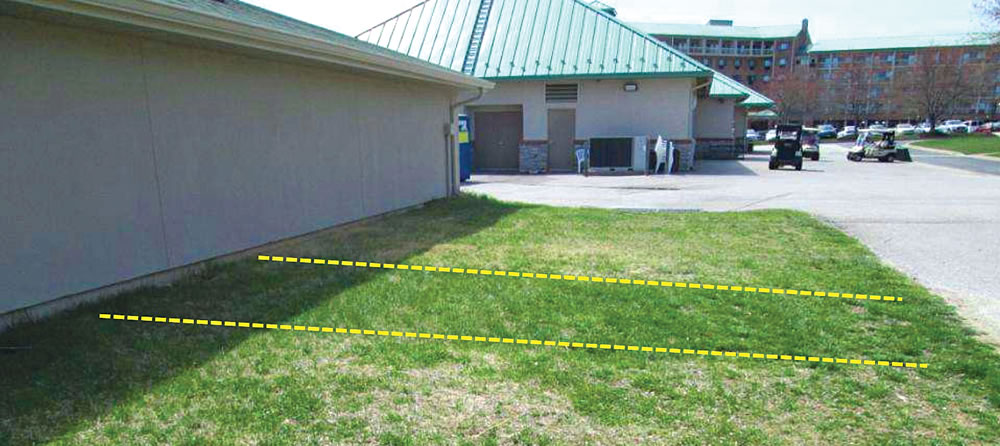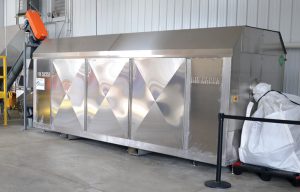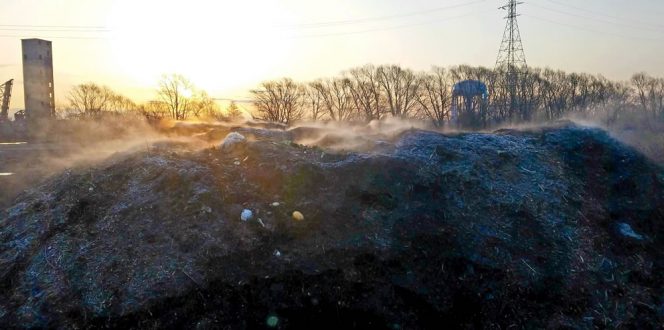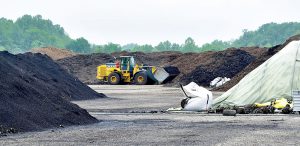BioCycle June 2018
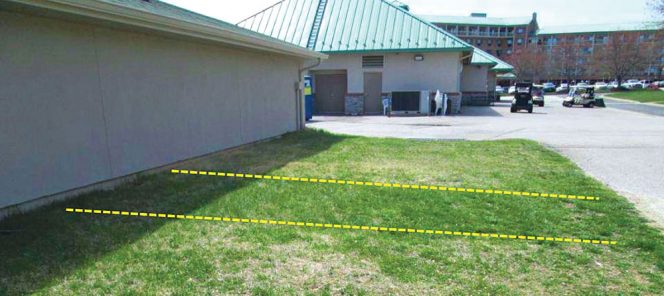
“Suburban subsoiling” plot established for the BioCycle East Coast Conference 2014 “Soils For The Chesapeake” Workshop currently stands out with its “uniform verdant turf cover.”
Ellicott City, Maryland: Compost-Amended Subsoil Plot Thrives
Turf Valley Country Club (TVCC) in Ellicott City is home to demonstration plots established as part of the BioCycle East Coast Conference at the Turf Valley Resort in October 2014. The two test plots were set up for the BioCycle “Soils For The Chesapeake” Workshop at the 2014 Conference, and compare standard treatment for turf establishment to “suburban subsoiling,” i.e., the combination of soil decompaction and compost amendment to restore healthy soil profiles in disturbed compacted urban soil. Stuart Schwartz of the Center for Urban Environmental Research and Education at the University of Maryland, Baltimore County, and Charlie Ulevich, Director of Golf Course and Grounds Maintenance at TVCC, led the collaboration to install and monitor the plots.
Recently, Schwartz stopped by TVCC to check on the plots and sent BioCycle this update and photo: “Our 10-foot by 10-foot subsoil (SS) plot stood out (to my eye) as the only area with uniform verdant turf cover. The standard turf (ST) plot — like the rest of the area in which we installed these two side-by-side plots — had very thin, shallow rooted cover dominated by what appears to be dormant turf and volunteer vegetation. What’s obvious to my eye needs a turf scientist to describe, but it sure looks like there’s some urban ecology going on in one of these identically seeded, identically managed plots.”
Briefly, the SS plot was decompacted with 24-inch deep complete cultivation. After 2-inches of compost was tilled in to a depth of 6 inches, the plot was seeded and lightly rolled to mimic effects of natural settlement and consolidation, and covered with straw mulch. The ST plot received light tillage and was seeded, followed by application of starter fertilizer, then rolled and covered with straw mulch. “You may recall that the standard treatment plot initially germinated faster and had deeper greener turf, while the complete cultivated compost-amended plot was a little slow in catching up, but then both plots looked great for the Conference,” Schwartz told BioCycle when he visited the plots in early spring of 2015. “This spring [2015], the trend is reversed — the treated plot is greening up sooner with a noticeably denser, more verdant turf. I’d like to believe we’ve got deeper, denser roots in a deeper soil profile, in which plant available nitrogen is not limiting as soil bacteria continue to remineralize the organic nutrients from the compost.”
Jackson, Wyoming: Terra Firma Expands In Nevada
Terra Firma Organics, Inc., which opened its first composting facility in Jackson Hole, and its second one in Las Vegas, announced that it has acquired Full Circle Soils & Compost in Carson City, Nevada. “With more than 20 years of experience, Full Circle has created a dynamic line of soil blends and mulches while operating a highly successful composting facility in Northern Nevada,” notes Terra Firm Founder Dane Buk. “This acquisition allows us to expand our knowledge base and understanding of unique and proprietary blends for landscape, construction and agricultural operations.” Compost will be sold on a greater scale through retailers under the established Full Circle brand. Terra Firma’s service area now reaches from Jackson Hole to Reno, Nevada, and south to Las Vegas.
Washington, D.C.: City Council Incentivizes Residential Composting
The Washington, D.C. City Council approved the Residential Composting Incentives Amendment Act of 2017 on May 1. This bill establishes a rebate or a voucher for up to $75 for the purchase of home composting or vermicomposting systems approved by the Department of Public Works (DPW). The DPW is required to offer an in-person composting training program, which residents would need to complete in order to qualify for the rebate or voucher, and to create educational materials about home composting so all residents can learn more about effective practices.
The bill was championed by the Institute for Local Self-Reliance (ILSR), which worked closely with the D.C. Council and with DPW to ensure a training component was included in the law so D.C. residents would receive the guidance and exposure to best practices necessary to succeed. Several weeks after D.C. Council passed the bill, ILSR released Yes! In My Backyard: A Home Composting Guide for Local Government. Coauthors Brenda Platt and Colton Fagundes profile 11 city and county home composting initiatives. Top replication tips to establish programs are to provide training and education, and offer bins for free or at discounted prices. Yes! In My Backyard (YIMBY) found that for every 10,000 households composting at home, between 1,400 and 5,000 tons/year could be diverted from curbside collection, with potential savings in avoided disposal costs alone ranging from $72,000 to $250,000.
Akron, Ohio: Zoo Begins On-Site Composting
The Akron Zoo installed an in-vessel composting unit in mid-February to process preconsumer, back-of-the-house commissary and concessions operations’ food waste, animal waste and bedding. The Big Hanna composter, supplied by Susteco AB, is sized to process up to 750 lbs/day of food waste. The Akron Zoo won the Association of Zoos and Aquariums’ Green Award in 2016, and composting on-site represents a major step towards achieving its aspiration to be a zero waste facility — one of nine goals outlined in its 2009 sustainability plan. Since that plan was published, the Zoo has diverted millions of pounds of food waste, paying a third-party hauler to truck the organics to a composter 45 minutes away. But the hauler wouldn’t take the Zoo’s compostable flatware or carnivore waste.
A subsequent change in management at the hauling company resulted in a significant increase in fees, leading the Akron Zoo to finding a new solution, explains Christopher E. Norman, the Zoo’s Director of Capital Projects and Sustainability. He reached out to Reworks, the Summit County Solid Waste District, which conducted a waste stream analysis and recommended that the Zoo purchase a Big Hanna. “We wanted something straightforward, ready-to-go and proven,” Norman notes. “We are in a residential neighborhood and landlocked, so not lots of acreage, and the composter is aerobic and low to no smell.”
Two correctional facilities in nearby Noble and Pickaway have the same type of composter. The Zoo tested its organic material in those units to see if it would break down. Following successful tests, the Ohio EPA provided a $160,000 cost-sharing grant, which the Zoo matched in order to buy a JWC Monster Industrial Grinder with custom 9-inch auger, a scale, and a 12-square-foot biofilter fabricated by Belmont Correctional Institution. Fed in batches, the feedstock remains in the vessel between 4 to 6 weeks, depending on its weight and volume. The resulting compost is stable and spreadable, according to Norman.
The Zoo is collecting, daily, 60 to 100 lbs of preconsumer food waste, 10 lbs of animal waste, and 200 lbs of straw bedding for composting. Current quantities of animal waste and straw bedding represent a small amount of what the Zoo generates every day, but Norman expects ultimately to divert 55 lbs/day of animal manure. “Unlike other facilities, where the ingredients have been only food waste and wood pellets, we have manures, food waste, compostable flatware, soiled newspaper, napkins, straw, hay, and wood shavings,” says Norman. “We have to be very deliberate with the management of the biological community in the composter. If we change things too quickly or too frequently, and the temperature or moisture changes, it will be hard to judge and correct the cause.”
Buffalo, New York: Composter Rises From River Restoration
Newly launched Buffalo River Compost was expected to begin accepting all city green waste by the end of April under its contract as the first registered composter within the Buffalo city limits. Founded by environmental consultants Brian Murphy and William Doebler, the company began composting at the site last fall in conjunction with a Buffalo Niagara Waterkeeper river habitat restoration project on an adjacent parcel. “It has been quite a ride,” says Murphy, noting how quickly Buffalo River Compost (BRC) went from a concept during its work with Waterkeeper to remove invasive species such as Japanese knotweed and restore it with native plants. “We identified the potential to create a beneficial reuse material while combating invasive species.”
Incoming feedstocks are mixed into piles using a front-end loader and a skid steer and composted in roughly 75-foot-long windrows for up to 45 days. “We have geared this site for the city’s material, which is primarily green waste,” says Doebler. To date, about 600 cy of mature compost has been manufactured (slated for delivery to a customer) and another 1,200 to 1,500 cy are in process, he adds. Compost will be sold primarily to general contractors. BRC’s city contract stipulates that the site is open to the public, but the company is still working out those details with the city.


